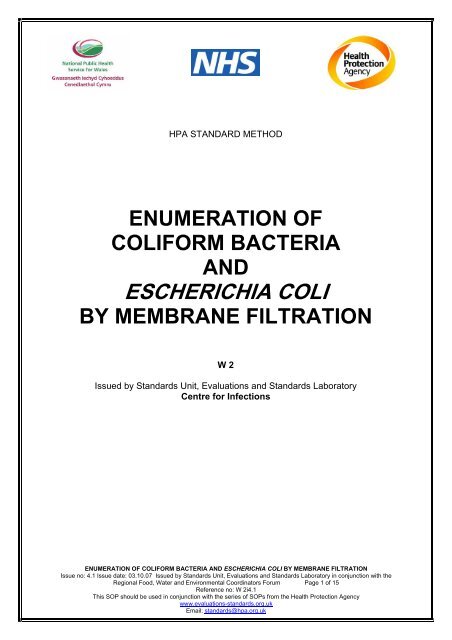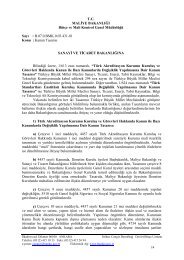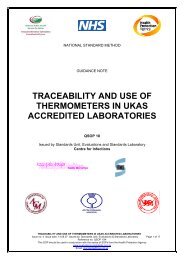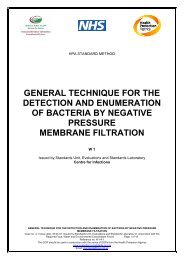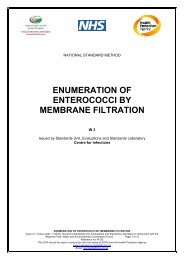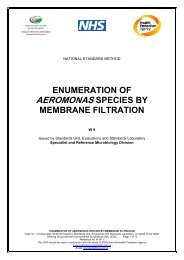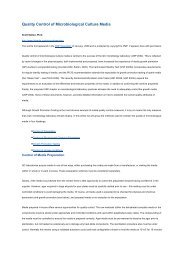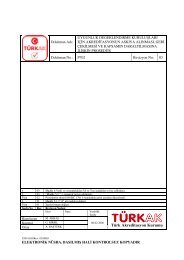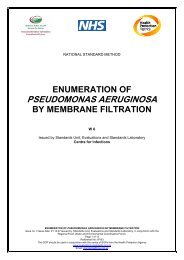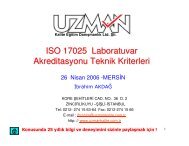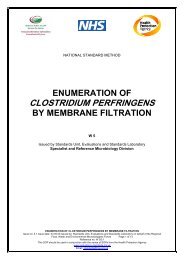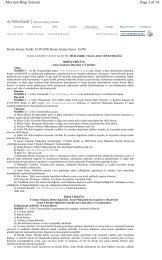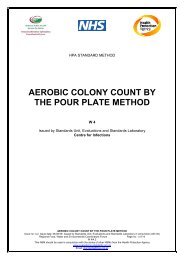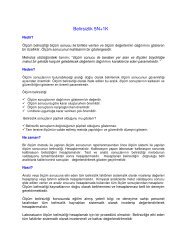Enumeration of coliform bacteria and Escherichia coli
Enumeration of coliform bacteria and Escherichia coli
Enumeration of coliform bacteria and Escherichia coli
You also want an ePaper? Increase the reach of your titles
YUMPU automatically turns print PDFs into web optimized ePapers that Google loves.
soake<br />
HPA STANDARD METHOD<br />
ENUMERATION OF<br />
COLIFORM BACTERIA<br />
AND<br />
ESCHERICHIA COLI<br />
BY MEMBRANE FILTRATION<br />
W 2<br />
Issued by St<strong>and</strong>ards Unit, Evaluations <strong>and</strong> St<strong>and</strong>ards Laboratory<br />
Centre for Infections<br />
ENUMERATION OF COLIFORM BACTERIA AND ESCHERICHIA COLI BY MEMBRANE FILTRATION<br />
Issue no: 4.1 Issue date: 03.10.07 Issued by St<strong>and</strong>ards Unit, Evaluations <strong>and</strong> St<strong>and</strong>ards Laboratory in conjunction with the<br />
Regional Food, Water <strong>and</strong> Environmental Coordinators Forum Page 1 <strong>of</strong> 15<br />
Reference no: W 2i4.1<br />
This SOP should be used in conjunction with the series <strong>of</strong> SOPs from the Health Protection Agency<br />
www.evaluations-st<strong>and</strong>ards.org.uk<br />
Email: st<strong>and</strong>ards@hpa.org.uk
STATUS OF NATIONAL STANDARD METHODS<br />
National St<strong>and</strong>ard Methods, which include st<strong>and</strong>ard operating procedures (SOPs), algorithms <strong>and</strong><br />
guidance notes, promote high quality practices <strong>and</strong> help to assure the comparability <strong>of</strong> diagnostic<br />
information obtained in different laboratories. This in turn facilitates st<strong>and</strong>ardisation <strong>of</strong> surveillance<br />
underpinned by research, development <strong>and</strong> audit <strong>and</strong> promotes public health <strong>and</strong> patient confidence<br />
in their healthcare services. The methods are well referenced <strong>and</strong> represent a good minimum<br />
st<strong>and</strong>ard for clinical <strong>and</strong> public health microbiology. However, in using National St<strong>and</strong>ard Methods,<br />
laboratories should take account <strong>of</strong> local requirements <strong>and</strong> may need to undertake additional<br />
investigations. The methods also provide a reference point for method development.<br />
National St<strong>and</strong>ard Methods are developed, reviewed <strong>and</strong> updated through an open <strong>and</strong> wide<br />
consultation process where the views <strong>of</strong> all participants are considered <strong>and</strong> the resulting documents<br />
reflect the majority agreement <strong>of</strong> contributors.<br />
Representatives <strong>of</strong> several pr<strong>of</strong>essional organisations, including those whose logos appear on the<br />
front cover, are members <strong>of</strong> the working groups which develop National St<strong>and</strong>ard Methods. Inclusion<br />
<strong>of</strong> an organisation’s logo on the front cover implies support for the objectives <strong>and</strong> process <strong>of</strong> preparing<br />
st<strong>and</strong>ard methods. The representatives participate in the development <strong>of</strong> the National St<strong>and</strong>ard<br />
Methods but their views are not necessarily those <strong>of</strong> the entire organisation <strong>of</strong> which they are a<br />
member. The current list <strong>of</strong> participating organisations can be obtained by emailing<br />
st<strong>and</strong>ards@hpa.org.uk.<br />
The performance <strong>of</strong> st<strong>and</strong>ard methods depends on the quality <strong>of</strong> reagents, equipment, commercial<br />
<strong>and</strong> in-house test procedures. Laboratories should ensure that these have been validated <strong>and</strong> shown<br />
to be fit for purpose. Internal <strong>and</strong> external quality assurance procedures should also be in place.<br />
Whereas every care has been taken in the preparation <strong>of</strong> this publication, the Health Protection<br />
Agency or any supporting organisation cannot be responsible for the accuracy <strong>of</strong> any statement or<br />
representation made or the consequences arising from the use <strong>of</strong> or alteration to any information<br />
contained in it. These procedures are intended solely as a general resource for practising<br />
pr<strong>of</strong>essionals in the field, operating in the UK, <strong>and</strong> specialist advice should be obtained where<br />
necessary. If you make any changes to this publication, it must be made clear where changes have<br />
been made to the original document. The Health Protection Agency (HPA) should at all times be<br />
acknowledged.<br />
The HPA is an independent organisation dedicated to protecting people’s health. It brings together<br />
the expertise formerly in a number <strong>of</strong> <strong>of</strong>ficial organisations. More information about the HPA can be<br />
found at www.hpa.org.uk.<br />
The HPA aims to be a fully Caldicott compliant organisation. It seeks to take every possible<br />
precaution to prevent unauthorised disclosure <strong>of</strong> patient details <strong>and</strong> to ensure that patient-related<br />
records are kept under secure conditions 1 .<br />
More details can be found on the website at www.evaluations-st<strong>and</strong>ards.org.uk. Contributions to the<br />
development <strong>of</strong> the documents can be made by contacting st<strong>and</strong>ards@hpa.org.uk.<br />
Please note the references are now formatted using Reference Manager s<strong>of</strong>tware. If you alter or delete text without<br />
Reference Manager installed on your computer, the references will not be updated automatically.<br />
Suggested citation for this document:<br />
Health Protection Agency (2007). <strong>Enumeration</strong> <strong>of</strong> <strong><strong>coli</strong>form</strong> <strong>bacteria</strong> <strong>and</strong> <strong>Escherichia</strong> <strong>coli</strong> by membrane<br />
filtration. National St<strong>and</strong>ard Method W 2 Issue 4.<br />
http://www.hpa-st<strong>and</strong>ardmethods.org.uk/pdf_sops.asp.<br />
ENUMERATION OF COLIFORM BACTERIA AND ESCHERICHIA COLI BY MEMBRANE FILTRATION<br />
Issue no: 4.1 Issue date: 03.10.07 Issued by St<strong>and</strong>ards Unit, Evaluations <strong>and</strong> St<strong>and</strong>ards Laboratory in conjunction with the<br />
Regional Food, Water <strong>and</strong> Environmental Coordinators Forum Page 2 <strong>of</strong> 15<br />
Reference no: W 2i4.1<br />
This SOP should be used in conjunction with the series <strong>of</strong> SOPs from the Health Protection Agency<br />
www.evaluations-st<strong>and</strong>ards.org.uk<br />
Email: st<strong>and</strong>ards@hpa.org.uk
INDEX<br />
STATUS OF NATIONAL STANDARD METHODS ................................................................................2<br />
INDEX......................................................................................................................................................3<br />
AMENDMENT PROCEDURE .................................................................................................................4<br />
SCOPE OF DOCUMENT ........................................................................................................................5<br />
INTRODUCTION .....................................................................................................................................5<br />
BACKGROUND........................................................................................................................................5<br />
1 DEFINITIONS ...................................................................................................................................6<br />
2 PRINCIPLE.......................................................................................................................................6<br />
3 SAFETY CONSIDERATIONS ..........................................................................................................6<br />
3.1 SAMPLE TRANSPORT AND STORAGE .............................................................................................6<br />
3.2 SAMPLE PROCESSING..................................................................................................................6<br />
4 EQUIPMENT.....................................................................................................................................7<br />
5 CULTURE MEDIA AND REAGENTS ..............................................................................................7<br />
6 SAMPLE PROCESSING ..................................................................................................................8<br />
6.1 SAMPLE PREPARATION AND DILUTIONS .........................................................................................8<br />
6.2 FILTRATION AND INCUBATION .......................................................................................................9<br />
6.3 COUNTING OF COLONIES..............................................................................................................9<br />
6.4 CONFIRMATORY TESTS ................................................................................................................9<br />
7 CALCULATION OF RESULTS ......................................................................................................10<br />
8 REPORTING...................................................................................................................................10<br />
9 QUALITY CONTROL .....................................................................................................................11<br />
9.1 MEMBRANE FILTRATION .............................................................................................................11<br />
9.2 CONFIRMATORY TESTS ..............................................................................................................11<br />
10 REFERENCE FACILITIES .............................................................................................................12<br />
11 ACKNOWLEDGEMENTS AND CONTACTS ................................................................................12<br />
FLOWCHART SHOWING THE PROCESS FOR THE ENUMERATION OF COLIFORM BACTERIA<br />
AND ESCHERICHIA COLI BY MEMBRANE FILTRATION ...............................................................13<br />
REFERENCES ......................................................................................................................................14<br />
ENUMERATION OF COLIFORM BACTERIA AND ESCHERICHIA COLI BY MEMBRANE FILTRATION<br />
Issue no: 4.1 Issue date: 03.10.07 Issued by St<strong>and</strong>ards Unit, Evaluations <strong>and</strong> St<strong>and</strong>ards Laboratory in conjunction with the<br />
Regional Food, Water <strong>and</strong> Environmental Coordinators Forum Page 3 <strong>of</strong> 15<br />
Reference no: W 2i4.1<br />
This SOP should be used in conjunction with the series <strong>of</strong> SOPs from the Health Protection Agency<br />
www.evaluations-st<strong>and</strong>ards.org.uk<br />
Email: st<strong>and</strong>ards@hpa.org.uk
AMENDMENT PROCEDURE<br />
Controlled document<br />
reference<br />
Controlled document title<br />
W 2<br />
<strong>Enumeration</strong> <strong>of</strong> <strong><strong>coli</strong>form</strong> <strong>bacteria</strong> <strong>and</strong> <strong>Escherichia</strong> <strong>coli</strong> by membrane<br />
filtration<br />
Each National St<strong>and</strong>ard Method has an individual record <strong>of</strong> amendments. The current amendments<br />
are listed on this page. The amendment history is available from st<strong>and</strong>ards@hpa.org.uk.<br />
On issue <strong>of</strong> revised or new pages each controlled document should be updated by the copyholder in<br />
the laboratory.<br />
Amendment<br />
Number/<br />
Date<br />
7/<br />
04.10.07<br />
Issue no.<br />
Discarded<br />
Insert<br />
Issue<br />
no.<br />
Page Section(s) involved Amendment<br />
4 4.1 9 6.2 Filtration <strong>and</strong><br />
incubation<br />
Corrected the temperature<br />
tolerance from 44°C ± 1°C to<br />
44°C ± 0.5°C in line with MDW<br />
2002.<br />
ENUMERATION OF COLIFORM BACTERIA AND ESCHERICHIA COLI BY MEMBRANE FILTRATION<br />
Issue no: 4.1 Issue date: 03.10.07 Issued by St<strong>and</strong>ards Unit, Evaluations <strong>and</strong> St<strong>and</strong>ards Laboratory in conjunction with the<br />
Regional Food, Water <strong>and</strong> Environmental Coordinators Forum Page 4 <strong>of</strong> 15<br />
Reference no: W 2i4.1<br />
This SOP should be used in conjunction with the series <strong>of</strong> SOPs from the Health Protection Agency<br />
www.evaluations-st<strong>and</strong>ards.org.uk<br />
Email: st<strong>and</strong>ards@hpa.org.uk
ENUMERATION OF COLIFORM BACTERIA AND<br />
ESCHERICHIA COLI BY MEMBRANE<br />
FILTRATION<br />
SCOPE OF DOCUMENT<br />
The method described is applicable to the enumeration <strong>of</strong> <strong><strong>coli</strong>form</strong> <strong>bacteria</strong> <strong>and</strong> <strong>Escherichia</strong> <strong>coli</strong> in<br />
water samples intended for human consumption <strong>and</strong> in pool waters by the membrane filtration<br />
technique. It may be used for environmental <strong>and</strong> recreational water samples but not for designated<br />
bathing waters sampled under the bathing water regulations 2 . These samples are analysed using<br />
methods detailed by the Environment Agency.<br />
INTRODUCTION<br />
Background<br />
Coliform <strong>bacteria</strong> are widely regarded as the most reliable microbiological indicator <strong>of</strong> water quality.<br />
They are found in the human <strong>and</strong> animal intestine <strong>and</strong> may serve as indicators <strong>of</strong> potential faecal<br />
pollution but may also be environmental in origin. ‘Faecal <strong><strong>coli</strong>form</strong> <strong>bacteria</strong>’ <strong>and</strong> E. <strong>coli</strong> are only found in<br />
human <strong>and</strong> animal intestines <strong>and</strong> tests for their presence in water are necessary to confirm that pollution<br />
is <strong>of</strong> human <strong>and</strong>/or animal origin. The term ‘faecal <strong><strong>coli</strong>form</strong>’ is not precise <strong>and</strong> is consequently not used<br />
in this National St<strong>and</strong>ard Method (NSM). In the context <strong>of</strong> water microbiology in the United Kingdom<br />
faecal <strong><strong>coli</strong>form</strong> <strong>bacteria</strong> are regarded as being E. <strong>coli</strong>.<br />
Coliform <strong>bacteria</strong> <strong>and</strong> E. <strong>coli</strong> are sensitive to the disinfection processes used in water treatment <strong>and</strong> do<br />
not usually multiply in water particularly in temperate zones. These organisms should not be present in<br />
a 250 mL sample <strong>of</strong> mineral waters or drinking waters in bottles <strong>and</strong> containers or 100 mL for other<br />
waters <strong>of</strong> potable quality 3-11 .<br />
This method is based on the method described in the Microbiology <strong>of</strong> Drinking Water 2002 document 12 .<br />
ENUMERATION OF COLIFORM BACTERIA AND ESCHERICHIA COLI BY MEMBRANE FILTRATION<br />
Issue no: 4.1 Issue date: 03.10.07 Issued by St<strong>and</strong>ards Unit, Evaluations <strong>and</strong> St<strong>and</strong>ards Laboratory in conjunction with the<br />
Regional Food, Water <strong>and</strong> Environmental Coordinators Forum Page 5 <strong>of</strong> 15<br />
Reference no: W 2i4.1<br />
This SOP should be used in conjunction with the series <strong>of</strong> SOPs from the Health Protection Agency<br />
www.evaluations-st<strong>and</strong>ards.org.uk<br />
Email: st<strong>and</strong>ards@hpa.org.uk
1 DEFINITIONS<br />
In the context <strong>of</strong> this method the following definitions apply:<br />
Presumptive <strong><strong>coli</strong>form</strong> <strong>bacteria</strong><br />
Organisms which produce acid from lactose <strong>and</strong> form all shades <strong>and</strong> sizes <strong>of</strong> yellow colonies on<br />
membranes soaked in membrane lauryl sulphate broth (MLSB) after incubation at 30°C for 4<br />
hours followed by 37°C for 14 hours.<br />
Presumptive E. <strong>coli</strong><br />
Organisms which produce acid from lactose <strong>and</strong> form all shades <strong>and</strong> sizes <strong>of</strong> yellow colonies<br />
on membranes soaked in MLSB after incubation at 30°C for 4 hours followed by incubation at<br />
44°C for 14 hours.<br />
Coliform <strong>bacteria</strong> (total <strong><strong>coli</strong>form</strong>s)<br />
Presumptive <strong><strong>coli</strong>form</strong> <strong>bacteria</strong> which produce acid from lactose at 37°C within 48 hours, are<br />
oxidase negative <strong>and</strong> possess β-galactosidase.<br />
E. <strong>coli</strong><br />
Presumptive E. <strong>coli</strong> which also produce indole from tryptophan after incubation at 44°C for 24<br />
hours. Most strains produce β-glucuronidase.<br />
2 PRINCIPLE<br />
A measured volume <strong>of</strong> the sample or a dilution <strong>of</strong> the sample is filtered through a membrane<br />
that is capable <strong>of</strong> retaining the organisms. The membrane is incubated on an absorbent pad<br />
saturated with a selective differential broth medium. Colonies <strong>of</strong> the target organisms are<br />
counted, confirmatory tests carried out <strong>and</strong> the result calculated as the colony count per<br />
100 mL or 250 mL <strong>of</strong> sample.<br />
3 SAFETY CONSIDERATIONS 13-18<br />
Normal microbiology laboratory precautions apply.<br />
Care should be taken where manual lifting <strong>of</strong> large volumes <strong>of</strong> water is required.<br />
3.1 SAMPLE TRANSPORT AND STORAGE<br />
Compliance with current postal <strong>and</strong> transportation regulations as stated in the Advisory<br />
Committee on Dangerous Pathogens 2005 19 is essential.<br />
3.2 SAMPLE PROCESSING<br />
Care must be taken when using a boiling waterbath (National St<strong>and</strong>ard Method: W1 Section<br />
2) 20 .<br />
• Amyl alcohol <strong>and</strong> concentrated hydrochloric acid used in the preparation <strong>of</strong> Kovacs reagent<br />
must be h<strong>and</strong>led with care<br />
• Acid protective gloves are to be worn when performing the indole test<br />
The above guidance should be supplemented with local COSHH <strong>and</strong> risk assessments<br />
ENUMERATION OF COLIFORM BACTERIA AND ESCHERICHIA COLI BY MEMBRANE FILTRATION<br />
Issue no: 4.1 Issue date: 03.10.07 Issued by St<strong>and</strong>ards Unit, Evaluations <strong>and</strong> St<strong>and</strong>ards Laboratory in conjunction with the<br />
Regional Food, Water <strong>and</strong> Environmental Coordinators Forum Page 6 <strong>of</strong> 15<br />
Reference no: W 2i4.1<br />
This SOP should be used in conjunction with the series <strong>of</strong> SOPs from the Health Protection Agency<br />
www.evaluations-st<strong>and</strong>ards.org.uk<br />
Email: st<strong>and</strong>ards@hpa.org.uk
4 EQUIPMENT<br />
Usual laboratory equipment <strong>and</strong> in addition:<br />
• Membrane filtration manifold<br />
• Filter funnels graduated to 50 mL <strong>and</strong> 100 mL<br />
• Pyrex vacuum flask with protective jacket or equivalent: large volume eg 5 L<br />
• Vacuum pump with moisture trap or protective filter, or alternative vacuum source<br />
• Stainless steel flat tipped forceps or sterilisable equivalent<br />
• Boiling waterbath (instrument steriliser)<br />
• Cycling incubator: 30°C ± 1.0°C <strong>and</strong> 37°C ± 1.0°C<br />
• Cycling incubator: 30°C ± 1.0°C <strong>and</strong> 44°C ± 0.5°C<br />
• Incubator: 37°C ± 1.0°C<br />
• Water bath: 44°C ± 0.5°C<br />
• Petri dishes<br />
• Sterile absorbent pads<br />
• Cellulose ester 0.45 µm gridded filters<br />
• Automatic pipettors <strong>and</strong> associated sterile pipette tips capable <strong>of</strong> delivering up to10 mL<br />
<strong>and</strong> 1 mL volumes (optional)<br />
• Pipettes / (sterile total delivery) 10 mL <strong>and</strong> 1 mL, graduated in 0.1 mL (optional)<br />
• Pastettes<br />
5 CULTURE MEDIA AND REAGENTS<br />
Media with the following formulations should be used. Follow MDW 2002 12<br />
preparation <strong>and</strong> shelf-life times.<br />
for in-house<br />
Equivalent commercial media may be used; follow the manufacturer’s instructions.<br />
Peptone saline diluent (Maximum recovery diluent)<br />
Peptone<br />
Sodium chloride<br />
Water<br />
pH 7.0 ± 0.2 at 25°C<br />
1.0 g<br />
8.5 g<br />
1 L<br />
Membrane lauryl sulphate broth (MLSB)<br />
Peptone<br />
Yeast extract<br />
Lactose<br />
Phenol red<br />
Sodium lauryl sulphate<br />
Water<br />
pH 7.4 ± 0.2 at 25°C<br />
40.0 g<br />
6.0 g<br />
30.0 g<br />
0.2 g<br />
1.0 g<br />
1 L<br />
Lactose peptone water (LPW)<br />
Peptone<br />
Sodium chloride<br />
Lactose<br />
Andrades indicator<br />
Water<br />
10.0 g<br />
5.0 g<br />
10.0 g<br />
10 mL<br />
1 L<br />
ENUMERATION OF COLIFORM BACTERIA AND ESCHERICHIA COLI BY MEMBRANE FILTRATION<br />
Issue no: 4.1 Issue date: 03.10.07 Issued by St<strong>and</strong>ards Unit, Evaluations <strong>and</strong> St<strong>and</strong>ards Laboratory in conjunction with the<br />
Regional Food, Water <strong>and</strong> Environmental Coordinators Forum Page 7 <strong>of</strong> 15<br />
Reference no: W 2i4.1<br />
This SOP should be used in conjunction with the series <strong>of</strong> SOPs from the Health Protection Agency<br />
www.evaluations-st<strong>and</strong>ards.org.uk<br />
Email: st<strong>and</strong>ards@hpa.org.uk
pH 7.5 ± 0.2 at 25°C<br />
2% Tryptone water (TW)<br />
Tryptone<br />
Sodium chloride<br />
Water<br />
pH 7.5 ± 0.2 at 25°C<br />
20.0 g<br />
5.0 g<br />
1 L<br />
MacConkey agar (MA)<br />
Bile Salts<br />
Peptone<br />
Lactose<br />
Sodium chloride<br />
Neutral red<br />
Agar<br />
Water<br />
pH 7.4 ± 0.2 at 25°C<br />
5.0 g<br />
20.0 g<br />
10.0 g<br />
5.0 g<br />
0.05 g<br />
12.0 g<br />
1 L<br />
Nutrient agar (NA)<br />
Meat extract<br />
Peptone<br />
Sodium chloride<br />
Agar<br />
Water<br />
pH 7.5 ± 0.2 at 25°C<br />
10.0 g<br />
10.0 g<br />
5.0 g<br />
15.0 g<br />
1 L<br />
Kovacs reagent 21<br />
p – Dimethylaminobenzaldehyde<br />
Amyl alcohol (analytical grade reagent,<br />
free from organic bases)<br />
Hydrochloric acid (concentrated)<br />
5.0 g<br />
75 mL<br />
25 mL<br />
Oxidase reagent (prepare fresh or use commercially prepared strips etc)<br />
Tetramethyl – p – phenylenediamine<br />
Hydrochloride<br />
Water<br />
0.1 g<br />
10 mL<br />
6 SAMPLE PROCESSING<br />
6.1 SAMPLE PREPARATION AND DILUTIONS<br />
The nature <strong>of</strong> the request <strong>and</strong> condition <strong>of</strong> the sample should be noted on arrival.<br />
Water samples should be received <strong>and</strong> h<strong>and</strong>led as described in National St<strong>and</strong>ard Method:<br />
W 1 Section 5 20 .<br />
The sample should be stored <strong>and</strong> transported at 2°C – 8°C. Samples should be analysed as<br />
soon as is practicable on the day <strong>of</strong> collection. In exceptional circumstances, if there is a<br />
delay, storage under the above conditions should not exceed 24 hours before the<br />
commencement <strong>of</strong> analysis.<br />
Following the procedures laid down in National St<strong>and</strong>ard Method: W 1 Section 6 20 , select<br />
suitable volumes for analysis <strong>and</strong> prepare any necessary dilutions.<br />
ENUMERATION OF COLIFORM BACTERIA AND ESCHERICHIA COLI BY MEMBRANE FILTRATION<br />
Issue no: 4.1 Issue date: 03.10.07 Issued by St<strong>and</strong>ards Unit, Evaluations <strong>and</strong> St<strong>and</strong>ards Laboratory in conjunction with the<br />
Regional Food, Water <strong>and</strong> Environmental Coordinators Forum Page 8 <strong>of</strong> 15<br />
Reference no: W 2i4.1<br />
This SOP should be used in conjunction with the series <strong>of</strong> SOPs from the Health Protection Agency<br />
www.evaluations-st<strong>and</strong>ards.org.uk<br />
Email: st<strong>and</strong>ards@hpa.org.uk
6.2 FILTRATION AND INCUBATION<br />
Place an absorbent pad in each Petri dish <strong>and</strong> add sufficient MLSB to saturate the pad<br />
(usually 2.5 mL depending on the br<strong>and</strong> <strong>of</strong> pad) <strong>and</strong> soak for at least 5 minutes. If<br />
necessary, remove any excess medium from the saturated pad using, for example, a sterile<br />
pipette / pastette, before the membrane is placed on the pad. For each br<strong>and</strong> <strong>of</strong> pad it is<br />
important to check the amount <strong>of</strong> medium that is to be added <strong>and</strong> the time necessary for<br />
soaking in order to prevent drying out during incubation.<br />
Following the procedures laid down in National St<strong>and</strong>ard Method: W 1 Section 6 20 :<br />
Filter a measured volume <strong>of</strong> sample through the membrane. For bottled mineral waters use 250<br />
mL water, for other potable quality waters use volumes <strong>of</strong> 100 mL. For surface waters use 100<br />
mL <strong>and</strong>, if expected to be highly polluted, use 10 mL <strong>and</strong> 1 mL volumes. Use two filters for each<br />
sample, one for <strong><strong>coli</strong>form</strong> <strong>bacteria</strong> <strong>and</strong> one for E. <strong>coli</strong>. For mains drinking water <strong>and</strong> pool waters<br />
it is acceptable to use a single membrane where the result is likely or expected to be negative,<br />
incubated at 37°C, for both <strong><strong>coli</strong>form</strong> <strong>bacteria</strong> <strong>and</strong> E. <strong>coli</strong>.<br />
Place the membrane on a pad soaked in MLSB. Put the membranes <strong>and</strong> pads in a sealed<br />
container <strong>and</strong> place in an incubator as follows:<br />
For <strong><strong>coli</strong>form</strong> <strong>bacteria</strong>: 30°C ± 1°C for 4 hours ± 1 hour followed by 37°C ± 1°C for 14 hours ± 1<br />
hour.<br />
For E. <strong>coli</strong>: 30°C ± 1°C for 4 hours ± 1 hour followed by 44°C ± 0.5°C for 14 hours ± 1 hour.<br />
6.3 COUNTING OF COLONIES<br />
After a minimum total incubation period <strong>of</strong> 18 hours, enumerate the presumptive <strong><strong>coli</strong>form</strong><br />
<strong>bacteria</strong> <strong>and</strong> presumptive E. <strong>coli</strong> by counting <strong>and</strong> recording all yellow colonies irrespective <strong>of</strong><br />
size. As colony colours are liable to change on cooling <strong>and</strong> st<strong>and</strong>ing, it is necessary to perform<br />
the count within 15 minutes <strong>of</strong> removing from the incubator 12 . It is important to note factors<br />
affecting the result eg when pink colonies are present in high numbers they may interfere with<br />
the growth or count <strong>of</strong> lactose fermenting colonies.<br />
6.4 CONFIRMATORY TESTS<br />
Select colonies for confirmation as described in National St<strong>and</strong>ard Method: W 1 Section 6.3 20 .<br />
Sub-culture colonies from both the 37°C <strong>and</strong> 44°C membranes for confirmation as <strong><strong>coli</strong>form</strong><br />
<strong>bacteria</strong> <strong>and</strong> E. <strong>coli</strong>. Presumptive <strong><strong>coli</strong>form</strong> <strong>bacteria</strong> isolated at 37°C may confirm as<br />
E. <strong>coli</strong> <strong>and</strong> presumptive E. <strong>coli</strong> colonies isolated at 44°C may confirm as <strong><strong>coli</strong>form</strong> <strong>bacteria</strong> but<br />
not E. <strong>coli</strong>. Also, colonies may be isolated on only one <strong>of</strong> the two membranes. When only<br />
one membrane has been used <strong>and</strong> incubated at 37°C, colonies should be confirmed for both<br />
<strong><strong>coli</strong>form</strong> <strong>bacteria</strong> <strong>and</strong> E. <strong>coli</strong>. If the confirmed count for E. <strong>coli</strong> from the 44°C membrane filter<br />
is greater than the confirmed count for <strong><strong>coli</strong>form</strong> <strong>bacteria</strong> from the 37°C membrane filter, then<br />
the higher count must be recorded as the confirmed count for <strong><strong>coli</strong>form</strong> <strong>bacteria</strong> disregarding<br />
the colonies on the 37°C membrane. For example, if zero <strong><strong>coli</strong>form</strong> <strong>bacteria</strong> have been<br />
isolated at 37°C but two E. <strong>coli</strong> isolated at 44°C, then the results should be reported as two<br />
<strong><strong>coli</strong>form</strong> <strong>bacteria</strong> <strong>and</strong> two E. <strong>coli</strong> 12 .<br />
Coliform <strong>bacteria</strong><br />
Sub-culture selected yellow colonies to lactose peptone water (LPW), MacConkey agar (MA)<br />
<strong>and</strong> nutrient agar (NA). Spread the MA <strong>and</strong> NA plates in a manner to give isolated colonies.<br />
Place the LPW in an incubator at 37°C. Examine for acid production after 20 ± 4 hours <strong>and</strong> if<br />
results are negative examine after further 20 ± 4 hours incubation. Place the MA <strong>and</strong> NA in an<br />
incubator at 37°C for 20 hours ± 4 hours. Coliform <strong>bacteria</strong> produce colonies on MA that are<br />
usually circular in shape, convex with a smooth surface <strong>and</strong> an entire edge. They are various<br />
ENUMERATION OF COLIFORM BACTERIA AND ESCHERICHIA COLI BY MEMBRANE FILTRATION<br />
Issue no: 4.1 Issue date: 03.10.07 Issued by St<strong>and</strong>ards Unit, Evaluations <strong>and</strong> St<strong>and</strong>ards Laboratory in conjunction with the<br />
Regional Food, Water <strong>and</strong> Environmental Coordinators Forum Page 9 <strong>of</strong> 15<br />
Reference no: W 2i4.1<br />
This SOP should be used in conjunction with the series <strong>of</strong> SOPs from the Health Protection Agency<br />
www.evaluations-st<strong>and</strong>ards.org.uk<br />
Email: st<strong>and</strong>ards@hpa.org.uk
shades <strong>of</strong> red in colour. If the growth on MA/NA is not pure then LPW should be repeated with<br />
a pure culture obtained from the MA/NA.<br />
Perform an oxidase test on colonies from the NA plate. Pure cultures are essential for this test<br />
<strong>and</strong> it may be necessary to make further sub-cultures from characteristic colonies on the MA to<br />
NA. Moisten a piece <strong>of</strong> filter paper in a Petri dish with 2 – 3 drops <strong>of</strong> freshly prepared oxidase<br />
reagent or equivalent. Using a stick, glass rod or platinum/plastic (not nichrome) loop transfer a<br />
colony <strong>of</strong> the test organism to the filter paper <strong>and</strong> rub it on the moistened area. A positive<br />
reaction is indicated by the appearance <strong>of</strong> a dark purple colour within 10 seconds. No colour<br />
change or a purplish colour which develops later are both negative reactions.<br />
Coliform <strong>bacteria</strong> are oxidase negative <strong>and</strong> produce acid from lactose.<br />
E. <strong>coli</strong><br />
Sub-culture the same colonies selected for confirmation as <strong><strong>coli</strong>form</strong> <strong>bacteria</strong> to LPW <strong>and</strong> TW.<br />
Place in a waterbath at 44°C for 20 hours ± 4 hours.<br />
Perform an indole test on the TW culture as follows:<br />
Add approximately 0.2 mL Kovacs reagent <strong>and</strong> shake gently. A deep red colour developing<br />
almost immediately in the upper layer indicates a positive result (indole production). E. <strong>coli</strong> is<br />
indole positive, produces acid in LPW <strong>and</strong> is oxidase negative.<br />
7 CALCULATION OF RESULTS<br />
Calculate the presumptive count <strong>of</strong> the test organisms as follows:<br />
Presumptive count / 100 mL = Number <strong>of</strong> colonies counted x 100<br />
Volume tested<br />
Following the procedures described in National St<strong>and</strong>ard Method: W 1 Section 7 20 , calculate<br />
the number <strong>of</strong> confirmed <strong><strong>coli</strong>form</strong> <strong>bacteria</strong> <strong>and</strong> E. <strong>coli</strong> present in the specified volume <strong>of</strong> the<br />
original sample.<br />
8 REPORTING<br />
Report the results using the procedure described in National St<strong>and</strong>ard Method: W 1 Section<br />
9 20 . Interpretation <strong>of</strong> results should follow QSOP 57 – The microbiological examination <strong>of</strong> water<br />
samples 22 .<br />
If <strong><strong>coli</strong>form</strong> <strong>bacteria</strong> or E. <strong>coli</strong> are not detected, report as:<br />
‘Not detected in 100 mL’<br />
If the test organisms are detected report as:<br />
‘a per 100 mL’<br />
where a is the confirmed count<br />
When E. <strong>coli</strong> has been confirmed from both the 37°C <strong>and</strong> 44°C membrane, report the higher<br />
count. If E. <strong>coli</strong> or other <strong><strong>coli</strong>form</strong> <strong>bacteria</strong> are detected at 44°C <strong>and</strong> when there are no colonies<br />
at 37°C be sure to report the colonies at 44°C as <strong><strong>coli</strong>form</strong> <strong>bacteria</strong>. It is illogical to report for<br />
example:<br />
E. <strong>coli</strong>: “2 per 100 mL” <strong>and</strong><br />
<strong><strong>coli</strong>form</strong> <strong>bacteria</strong>: “Not detected in 100 mL” from the same sample.<br />
ENUMERATION OF COLIFORM BACTERIA AND ESCHERICHIA COLI BY MEMBRANE FILTRATION<br />
Issue no: 4.1 Issue date: 03.10.07 Issued by St<strong>and</strong>ards Unit, Evaluations <strong>and</strong> St<strong>and</strong>ards Laboratory in conjunction with the<br />
Regional Food, Water <strong>and</strong> Environmental Coordinators Forum Page 10 <strong>of</strong> 15<br />
Reference no: W 2i4.1<br />
This SOP should be used in conjunction with the series <strong>of</strong> SOPs from the Health Protection Agency<br />
www.evaluations-st<strong>and</strong>ards.org.uk<br />
Email: st<strong>and</strong>ards@hpa.org.uk
For natural mineral waters, bottled waters or waters in containers, the result is reported as the<br />
count per 250 mL.<br />
9 QUALITY CONTROL<br />
9.1 MEMBRANE FILTRATION<br />
When the membrane filtration technique is used, internal quality control procedures must be<br />
carried out at least once daily depending on the workload <strong>of</strong> the laboratory. If more than one<br />
batch <strong>of</strong> media is used it is necessary to repeat the quality control for each batch (see National<br />
St<strong>and</strong>ard Method W 1 Section 10) 20 .<br />
The quantitative internal quality controls are performed using suspensions <strong>of</strong> positive <strong>and</strong><br />
negative control organisms known to contain less than 100 colony forming units in the volume<br />
filtered.<br />
Positive controls<br />
<strong>Escherichia</strong> <strong>coli</strong> NCTC 9001 for incubation at 37°C (<strong><strong>coli</strong>form</strong> <strong>bacteria</strong> positive) or 44°C (E. <strong>coli</strong><br />
positive)<br />
Klebsiella aerogenes NCTC 9528 for incubation at 37°C (<strong><strong>coli</strong>form</strong> <strong>bacteria</strong> positive)<br />
Negative controls<br />
Klebsiella aerogenes NCTC 9528 for incubation at 44°C<br />
Pseudomonas aeruginosa NCTC 10662<br />
Blank control<br />
Filter 100 mL <strong>of</strong> sterile distilled water or peptone saline diluent using the same funnel as used for<br />
the positive control following disinfection.<br />
Incubate all quality control tests in parallel with routine tests, proceed with confirmatory tests <strong>and</strong><br />
determine the counts.<br />
9.2 CONFIRMATORY TESTS<br />
For each batch <strong>of</strong> confirmatory tests inoculate known positive <strong>and</strong> negative controls as shown<br />
below:<br />
Lactose peptone water<br />
Test strains<br />
37°C 44°C<br />
24 or 48 hours 24 hours<br />
E. <strong>coli</strong> NCTC 9001 Not necessary Acid<br />
Klebsiella aerogenes NCTC 9528 Acid No growth<br />
Pseudomonas aeruginosa NCTC 10662 No acid No acid<br />
ENUMERATION OF COLIFORM BACTERIA AND ESCHERICHIA COLI BY MEMBRANE FILTRATION<br />
Issue no: 4.1 Issue date: 03.10.07 Issued by St<strong>and</strong>ards Unit, Evaluations <strong>and</strong> St<strong>and</strong>ards Laboratory in conjunction with the<br />
Regional Food, Water <strong>and</strong> Environmental Coordinators Forum Page 11 <strong>of</strong> 15<br />
Reference no: W 2i4.1<br />
This SOP should be used in conjunction with the series <strong>of</strong> SOPs from the Health Protection Agency<br />
www.evaluations-st<strong>and</strong>ards.org.uk<br />
Email: st<strong>and</strong>ards@hpa.org.uk
Oxidase test<br />
Test strains<br />
Pseudomonas aeruginosa NCTC 10662<br />
Positive (purple)<br />
E. <strong>coli</strong> NCTC 9001 Negative (colourless)<br />
Indole production in tryptone water 44°C/24 hours<br />
Test strains<br />
E. <strong>coli</strong> NCTC 9001 Positive (red)<br />
Klebsiella aerogenes NCTC 9528 Negative (colourless)<br />
Pseudomonas aeruginosa NCTC 10662<br />
Negative (colourless)<br />
10 REFERENCE FACILITIES<br />
N/A<br />
11 ACKNOWLEDGEMENTS AND CONTACTS<br />
This National St<strong>and</strong>ard Method has been developed, reviewed <strong>and</strong> revised by the Water<br />
Working Group for St<strong>and</strong>ard Methods (http://www.hpast<strong>and</strong>ardmethods.org.uk/wg_water.asp).<br />
The contributions <strong>of</strong> many individuals in Food,<br />
Water <strong>and</strong> Environmental laboratories, reference laboratories <strong>and</strong> specialist organisations<br />
who have provided information <strong>and</strong> comment during the development <strong>of</strong> this document are<br />
acknowledged.<br />
The National St<strong>and</strong>ard Methods are issued by St<strong>and</strong>ards Unit, Evaluations <strong>and</strong> St<strong>and</strong>ards<br />
Laboratory, Centre for Infections, Health Protection Agency London.<br />
For further information please contact us at:<br />
St<strong>and</strong>ards Unit<br />
Evaluations <strong>and</strong> St<strong>and</strong>ards Laboratory<br />
Centre for Infections<br />
Health Protection Agency<br />
Colindale<br />
London<br />
NW9 5EQ<br />
E-mail: st<strong>and</strong>ards@hpa.org.uk<br />
ENUMERATION OF COLIFORM BACTERIA AND ESCHERICHIA COLI BY MEMBRANE FILTRATION<br />
Issue no: 4.1 Issue date: 03.10.07 Issued by St<strong>and</strong>ards Unit, Evaluations <strong>and</strong> St<strong>and</strong>ards Laboratory in conjunction with the<br />
Regional Food, Water <strong>and</strong> Environmental Coordinators Forum Page 12 <strong>of</strong> 15<br />
Reference no: W 2i4.1<br />
This SOP should be used in conjunction with the series <strong>of</strong> SOPs from the Health Protection Agency<br />
www.evaluations-st<strong>and</strong>ards.org.uk<br />
Email: st<strong>and</strong>ards@hpa.org.uk
FLOWCHART SHOWING THE PROCESS FOR THE<br />
ENUMERATION OF COLIFORM BACTERIA AND<br />
ESCHERICHIA COLI BY MEMBRANE FILTRATION<br />
Transport to laboratory at 2°C – 8°C out <strong>of</strong> direct sunlight<br />
in suitable containers<br />
<br />
Store at 2°C – 8°C in the dark <strong>and</strong> analyse as soon as is practicable on the day <strong>of</strong> collection,<br />
otherwise within 24 hours <strong>of</strong> collection<br />
<br />
Mix sample well <strong>and</strong> make any necessary dilutions<br />
<br />
Filter<br />
<br />
Place filter on pad soaked in MLSB<br />
<br />
Incubate at 30°C ± 1°C for 4 hours ± 1 hour <strong>and</strong><br />
37°C for 14hours ± 1 hour<br />
<br />
Incubate at 30°C ± 1°C for 4 hours ± 1 hour<br />
<strong>and</strong> 44°C for 14 hours ± 1 hour<br />
<br />
Count yellow colonies<br />
within 15 minutes <strong>of</strong> removal from incubator<br />
<br />
<br />
Count yellow colonies<br />
within 15 minutes <strong>of</strong> removal from incubator<br />
Sub-culture to LPW, MA, <strong>and</strong> NA (oxidase test)<br />
for incubation at 37°C (<strong><strong>coli</strong>form</strong> <strong>bacteria</strong>) <strong>and</strong> to LPW <strong>and</strong> TW at 44°C (E. <strong>coli</strong>)<br />
<br />
Perform biochemical tests <strong>and</strong> calculate counts <strong>of</strong> <strong><strong>coli</strong>form</strong> <strong>bacteria</strong> <strong>and</strong> E. <strong>coli</strong><br />
<br />
Report <strong>and</strong> interpret using QSOP 57 – The microbiological examination <strong>of</strong> water samples 22<br />
ENUMERATION OF COLIFORM BACTERIA AND ESCHERICHIA COLI BY MEMBRANE FILTRATION<br />
Issue no: 4.1 Issue date: 03.10.07 Issued by St<strong>and</strong>ards Unit, Evaluations <strong>and</strong> St<strong>and</strong>ards Laboratory in conjunction with the<br />
Regional Food, Water <strong>and</strong> Environmental Coordinators Forum Page 13 <strong>of</strong> 15<br />
Reference no: W 2i4.1<br />
This SOP should be used in conjunction with the series <strong>of</strong> SOPs from the Health Protection Agency<br />
www.evaluations-st<strong>and</strong>ards.org.uk<br />
Email: st<strong>and</strong>ards@hpa.org.uk
REFERENCES<br />
1. Department <strong>of</strong> Health NHS Executive: The Caldicott Committee. Report on the review <strong>of</strong> patientidentifiable<br />
information. London. December 1997.<br />
2. The Bathing Waters (Classification) Regulations 1991: Statutory Instrument No. 1597. HMSO.<br />
http://www.opsi.gov.uk/si/si1991/Uksi_19911597_en_1.htm.<br />
3. The Natural Mineral Water, Spring Water <strong>and</strong> Bottled Drinking Water Regulations (Statutory<br />
Instrument No. 666). London: HMSO; 2003.<br />
4. The Private Water Supplies Regulations (Statutory Instrument No. 2790). London: HMSO; 1991.<br />
5. The Water Supply (Water Quality) (Amendment) Regulations (Statutory Instrument No. 2885).<br />
London: HMSO; 2001.<br />
6. The Drinking Water in Containers Regulations (Statutory Instrument No. 743). London: HMSO;<br />
1994.<br />
7. PHLS. Hygiene for Hydrotherapy Pools. 2 nd ed. London: PHLS; 1999.<br />
8. Health <strong>and</strong> Safety Executive, Health Protection Agency. Management <strong>of</strong> Spa Pools - Controlling<br />
the Risks <strong>of</strong> Infection. http://www.hpa.org.uk/publications/2006/spa_pools/spa_pools.pdf.<br />
9. Pool Water Treatment Advisory group, editor. Swimming Pool Water - Treatment <strong>and</strong> Quality<br />
St<strong>and</strong>ards. Greenhouse Publishing; 1999.<br />
10. Industry Guide to Good Hygiene Practice: Vending <strong>and</strong> Dispensing Guide Supplement (to the<br />
Catering Guide). Chadwick House Group ; 2000.<br />
11. Council Directive 98/83/EC: Relating to the Quality <strong>of</strong> Water Intended for Human Consumption.<br />
Official Journal <strong>of</strong> the European Communities; 1998. p. L330-32-L330/53.<br />
12. St<strong>and</strong>ing Committee <strong>of</strong> Analysts. Environment Agency. The Microbiology <strong>of</strong> Drinking Water<br />
(2002). Methods for the Examination <strong>of</strong> Waters <strong>and</strong> Associated Materials - Part 4: Methods for the<br />
isolation <strong>and</strong> enumeration <strong>of</strong> <strong><strong>coli</strong>form</strong> <strong>bacteria</strong> <strong>and</strong> <strong>Escherichia</strong> <strong>coli</strong> (including E. <strong>coli</strong> 0157:H7).<br />
London. www.environment-agency.gov.uk/commondata/acrobat/mdwpart4.pdf .<br />
13. Public Health Laboratory Service St<strong>and</strong>ing Advisory Committee on Laboratory Safety. Safety<br />
Precautions: Notes for Guidance. 4 th ed. London: Public Health Laboratory Service (PHLS); 1993.<br />
14. Control <strong>of</strong> Substances Hazardous to Health Regulations 2002. General COSHH. Approved Code<br />
<strong>of</strong> Practice <strong>and</strong> Guidance, L5. Suffolk: HSE Books; 2002.<br />
15. Health <strong>and</strong> Safety Executive. 5 steps to risk assessment: a step by step guide to a safer <strong>and</strong><br />
healthier workplace, IND (G) 163 (REVL). Suffolk: HSE Books; 2002.<br />
16. Health <strong>and</strong> Safety Executive. A guide to risk assessment requirements: common provisions in<br />
health <strong>and</strong> safety law, IND (G) 218 (L). Suffolk: HSE Books; 2002.<br />
17. NHS Estates. Health Building Note 15. Facilities for pathology services. 2nd ed. London: The<br />
Stationary Office; 2005.<br />
18. Advisory Committee on Dangerous Pathogens. The management, design <strong>and</strong> operation <strong>of</strong><br />
microbiological containment laboratories. Suffolk: HSE Books; 2001.<br />
ENUMERATION OF COLIFORM BACTERIA AND ESCHERICHIA COLI BY MEMBRANE FILTRATION<br />
Issue no: 4.1 Issue date: 03.10.07 Issued by St<strong>and</strong>ards Unit, Evaluations <strong>and</strong> St<strong>and</strong>ards Laboratory in conjunction with the<br />
Regional Food, Water <strong>and</strong> Environmental Coordinators Forum Page 14 <strong>of</strong> 15<br />
Reference no: W 2i4.1<br />
This SOP should be used in conjunction with the series <strong>of</strong> SOPs from the Health Protection Agency<br />
www.evaluations-st<strong>and</strong>ards.org.uk<br />
Email: st<strong>and</strong>ards@hpa.org.uk
19. Advisory Committee on Dangerous Pathogens. Biological agents: Managing the risks in<br />
laboratories <strong>and</strong> healthcare premises. HSE.<br />
http://www.advisorybodies.doh.gov.uk/acdp/publications.htm#1.<br />
20. National St<strong>and</strong>ard Method W 1 - General technique for the detection <strong>of</strong> <strong>bacteria</strong> by membrane<br />
filtration. London: Health Protection Agency; 2007.<br />
21. Barrow GI, Feltham R K A, editors. Cowan <strong>and</strong> Steel's Manual for the Identification <strong>of</strong> Medical<br />
Bacteria. 3rd ed. Cambridge: Cambridge University Press; 1993.<br />
22. National St<strong>and</strong>ard Method QSOP 57 - The microbiological examination <strong>of</strong> water samples. London:<br />
Health Protection Agency; 2005.<br />
ENUMERATION OF COLIFORM BACTERIA AND ESCHERICHIA COLI BY MEMBRANE FILTRATION<br />
Issue no: 4.1 Issue date: 03.10.07 Issued by St<strong>and</strong>ards Unit, Evaluations <strong>and</strong> St<strong>and</strong>ards Laboratory in conjunction with the<br />
Regional Food, Water <strong>and</strong> Environmental Coordinators Forum Page 15 <strong>of</strong> 15<br />
Reference no: W 2i4.1<br />
This SOP should be used in conjunction with the series <strong>of</strong> SOPs from the Health Protection Agency<br />
www.evaluations-st<strong>and</strong>ards.org.uk<br />
Email: st<strong>and</strong>ards@hpa.org.uk


